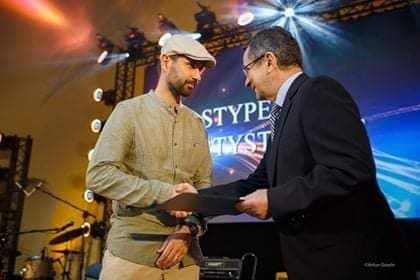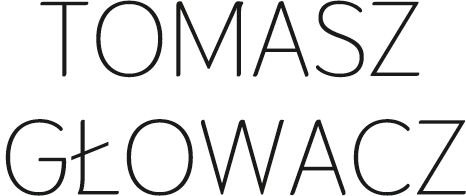The picture lives in a flash
Tomasz Głowacz knows that what is the most essential appears on its own in the creative process. One cannot decide to simply paint beauty. An artist who conducts a dialogue with the matter at the moment of creation has a chance to discover it, finda form that comes from the outside. While describing his series called “Mountains Abstractions”, he confesses: “I desire to forma creative space where the artistic creation will be dominated by the subconscious creative act. The forms of artistic expression, such as color and texture, more or less controlled pouring of paint, will be used to build a painting form. This form inspired bya mountain landscape combined with an intuitive gesture, rapidity of work, and spontaneous decision, I hope will lead me to original (primal/fontal) artistic effects. “
These are not just painted pictures, for which there could be a sketch, idea, or images that were formed in the author’s mind. Here, every form was created during a painting performance, during trials. They had to happen, come, and cope in the empty space of the painting. They had to start generating an inner meaning that represents their justification. That kind of image lives in a flash that penetrates all its elements, strengthened for a moment by this invigorating blast, and then immediately plunges into the darkness of matter. Creating, in the way that Tomasz Głowacz presents, is a number of circumstances that irresistibly lure the painter. The elements of the picture are never illustrative but dialectical. They form a system where each of them increases its power of influence through the game of harmony and destruction.
That was also the case in Kantor’s theater, with which the Author engages in dialogue. Once caught in the mechanism ofa dangerous theater machine – materials, living bodies, sounds, objects – we are irrevocably crushed. It is inside this mass, this unique matter of reality of the lowest rank, that the director searches for: it is the place where he destroys, forms, demonstrates samples of a surprising existence situated between life and death (1). Only when the matter becomes deprived of all function may it reach the absolute, eternity, and thus art noted Kantor. Both in theater and painting, he also manifested his reluctance to createa space as an empty container, where various elements of performance or image could be arranged. He was looking for artistic and emotional space simultaneously. Being an outspoken adversary of composition, he led theatrical work in many fields. When we look at the painting by Tomasz Głowacz in this way, we are faced with certain enlightenment: the colorful tumult will suddenly uncover the pulsation of the matter before we see a form in it. I imagine them as allover compositions, without the initial concept, which only the author catches into the trap of the “scene”. Faced with the disturbing specters that appear on the paper, the creator is as confused as the viewer. It is because he knows that neither the intention nor the lack of it is of adequate help. The stain of black ink that sticks to the paper with an energetic gesture seems to be merely saying: I am, I belong to nobody, and no one is looking for me. I do not show any psychological truth, I am an artistic manifestation.

Against them, the mind must distance itself, because the moment we want to attach the label of association, that sense dissolves into the matter, and we stand embarrassed by our tendency to catch the meaning. These are real reality traps. They have the power to transport the viewer to places with undefined borders, contradicting colors, and vague roots. Just like DOORS: a frequent actor-prop in Kantor’s performances “Nadobnisiei koczkodany”; “Wielopole, Wielopole”, ” Niech szczezną artyści ” which are an implication to the existence of another space, closed to our eyes. An artist who touches on abstraction names things that exist, but more so those that are not yet there or could appear. Abstraction is not an end but means to bring out all kinds of content impossible to convey in the illustrated order.
The subject of the mountain landscape, to which Tomasz Głowacz refers, seems to be a very accurate bridge between the concrete and the abstract. I realized it while contemplating the relationship between the format, scale of work, and the type of performance. Is it a coincidence that 20th and 21st-century artists exploit gigantic canvases facing non-representational art? The author of the series we are observing also felt the need to enlarge his works in print, feeling that this scale is more true-to-life for them. Note: when we want to look at an old painting, we have to get very close to see details, symbols and discover their secret. This distance was gradually increasing, for instance, in the Baroque period. In the twentieth century, the creation almost inherently repels man. It makes him look at himself from a distance, perhaps paying attention to qualities that are not noticeable up close. Just like when standing on the top, we immerse our gaze into the vast view of space. The detail does not disappear so much as it takes on meaning as a part of some new matter. In this sense, one can say that abstraction is not so much an image as a kind of “transmission channel”.
Kantor understood painting perfectly. He was certain that the painter was dependent on a whole spectrum of activities other than himself. In one of his essays, Zygmunt Bauman neatly observed this mechanism: We live much before the present. Our interpretations are ahead of our senses, they look ahead. The world we inhabit is always a step, a millimeter, a kilometer, or a light-year ahead of the world we experience. (…) The role of the ideals is to guide us through a territory that has not yet been explored and not marked on maps (2). Beauty is one of the ideals that leads us beyond the world that exists. Its value lies in its guiding force. Is it about the perfection of the compositional layout and the exquisite color? These qualities are desirable but insufficient. Beauty is defined by the configuration of meanings hidden under the painting. If the artist is successful, we will see the light of a distant star.
1 Brunella Eruli, Maszyny Kantora w: Tadeusz Kantor. Obiekty/Przedmioty. Zbiory Cricoteki
wyd, Ośrodek Dokumentacji Sztuki Tadeusza Kantora CRICOTEKA, Kraków 2007.
2 Zygmunt Bauman, Piękno to czy marzenie senne, które leka się przebudzenia
s.41 w: Miedzy chwila a pięknem. O sztuce w rozpędzonym świecie, Wyd. Oficyna, Łódź 2010.
